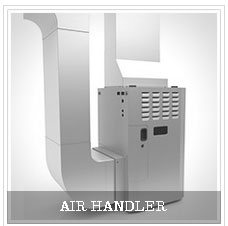I’ve got a rattle coming from my heating and air system.
Air handlers are an important component to any HVAC system. Usually, an air handler is a large metal box containing a blower, heating and/or cooling elements, filter racks or chambers, sound attenuators, and dampers. Air handlers usually connect to ductwork that distributes the conditioned air through the home, and returns it to the air handler. Sometimes air handlers discharge and admit air directly to and from the space served, without necessary ductwork.
Air handlers typically are comprised of:
Blower/fan – usually located in a large squirrel cage blower driven by an electric motor to move the air. The blower may operate at a single speed, offer a variety of pre-set speeds, or be driven by a variable drive so as to allow a wide range of air flow rates.
Heating and/or cooling elements – depending on the location and the application, air handlers may need to provide heating, or cooling, or both to change the supply air temperature.
Filters – air filters are almost always present and needed in order to provide clean dust-free air to the home interior.
Humidifier – is often necessary in colder climates where continuous heating will make the air drier, resulting in uncomfortable air quality and increased static electricity.
Mixing chamber – to maintain indoor air quality, some air handlers commonly allow the use of outside air into, and the exhausting of air from the home. A mixing chamber is used with dampers to control the ratio between the return, outside, and exhaust air.
Controls – are necessary to regulate every aspect of an air handler, such as: flow rate of air, supply air temperature, mixed air temperature, humidity, air quality. Common control components include temperature sensors, humidity sensors, sail switches, actuators, motors and controllers.
Vibration isolators – since blowers in an air handler can create substantial vibration, are normally inserted into the duct immediately before and after the air handler and often also between the fan compartment and the rest of the air handler.
An air handler is usually located in the garage, a closet, or in the attic unless it is part of a package unit, then the air handler is incorporated in the system. The air handler can be an up flow air handler, down flow air handler, or horizontal flow air handling unit.
Call our experienced technicians and we’ll go over your options with you.

- Blower Motor – measure amperage and voltage for proper operation
- Thermostat – test for proper operation, calibrate and level
- Clean existing air filter (as needed)
- Bearing – inspect for wear and lubricate
- Clean indoor coil if accessible
- Condensate Drain – flush and treat with anti-algae
- Condenser Coil – inspect
- Refrigerant – monitor operating pressures
- Safety Devices – inspect for proper operation
- Electrical Disconnect Box – inspect for proper rating and safe installation
- Electrical Wiring – inspect and tighten connections
- Test/inspect contactors for burned, pitted contacts
- Inspect electrical for exposed wiring
- Inspect and test capacitors
- Inspect fan blade
- Clean condenser coil/ remove debris
- Inspect service valves for proper operation
- Measure Supply/Return temperature differential
- Inspect duct work for energy loss
- Compressor – monitor, measure amperage and volt draw and wiring connections
$10 Tune-Up Coupon
Keep Your Air-Conditioner at Peak Efficiency with an Annual Tune-Up
Save $10 with coupon – Call 208-642-9846 to schedule your
Air-Conditioner Tune-Up, Cleaning and Safety Inspection
